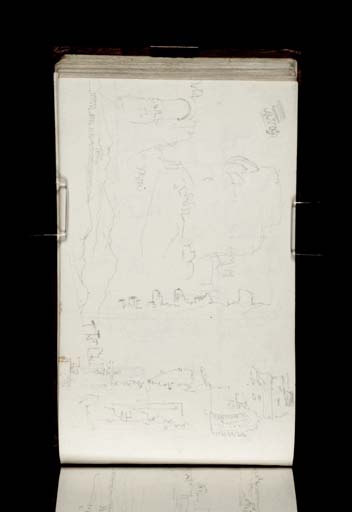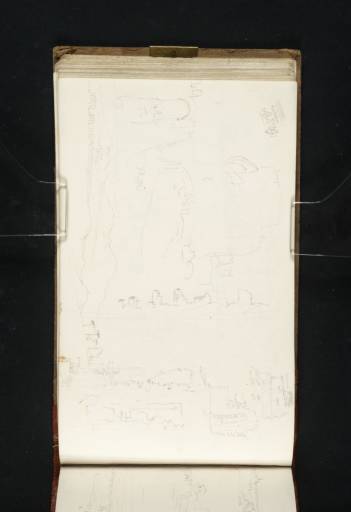Joseph Mallord William Turner Several Sketches of the Via Appia Antica, Including Two Views of the Tomb of Cecilia Metella, Rome 1819
Image 1 of 2
-
 Joseph Mallord William Turner, Several Sketches of the Via Appia Antica, Including Two Views of the Tomb of Cecilia Metella, Rome 1819
Joseph Mallord William Turner, Several Sketches of the Via Appia Antica, Including Two Views of the Tomb of Cecilia Metella, Rome 1819 -
 Joseph Mallord William Turner, Several Sketches of the Via Appia Antica, Including Two Views of the Tomb of Cecilia Metella, Rome 1819 (Enhanced image)Enhanced image
Joseph Mallord William Turner, Several Sketches of the Via Appia Antica, Including Two Views of the Tomb of Cecilia Metella, Rome 1819 (Enhanced image)Enhanced image
Joseph Mallord William Turner,
Several Sketches of the Via Appia Antica, Including Two Views of the Tomb of Cecilia Metella, Rome
1819
Joseph Mallord William Turner 1775–1851
Folio 47 Verso:
Several Sketches of the Via Appia Antica, Including Two Views of the Tomb of Cecilia Metella, Rome 1819
D15385
Turner Bequest CLXXXII 47 a
Turner Bequest CLXXXII 47 a
Pencil on white wove paper, 113 x 189 mm
Inscribed by the artist ‘[?Road]’ to the right of arched gateway, bottom left
Accepted by the nation as part of the Turner Bequest 1856
References
1909
A.J. Finberg, A Complete Inventory of the Drawings of the Turner Bequest, London 1909, vol.I, p.538, as ‘Mole of Cæcilia Metella, &tc.’.
Turner made a number of sketches of the Via Appia Antica, the ancient Roman thoroughfare from Rome to Brindisi in south-east Italy. Known as ‘the Queen of Roads’, the Appian Way was famous for its characteristic straightness and the numerous tombs and catacombs lining the route. This page contains multiple variant views in a number of formats. The largest complete horizonal sketch depicts the Tomb of Cecilia Metella, a large circular mausoleum and one of Rome’s most celebrated ancient monuments, see folio 47 (D15384). The viewpoint, taken from the south, is similar to that in Piranesi’s etching Tomb of Cecilia Metella (Sepolcro di Cecilia Metella) 1762 from the Vedute di Roma, with the arched doorway of a ruined convent on the left.1 In the top left-hand corner above Turner has drawn a detail from the frieze of festoons and oxen skulls which runs around the entablature, underneath the crenellated top of the tower. This decoration led to the tomb being popularly known as the ‘Capo di Bove’ (Oxen’s Head).2
In the bottom left-hand corner, beneath the study of the Tomb of Cecilia Metella is another landscape view which depicts a stretch of ruined aqueduct with distant mountains beyond. This is probably the Aqua Claudia (Claudian Aqueduct) which ran alongside the Via Appia Antica. The surviving sections in the Roman campagna, many of which can still be seen today, presented a popular picturesque subject for artists.
Bisecting the page and running vertically in parallel with the gutter of the sketchbook is a separate sketch of tombs, probably monuments on the Via Appia Antica. Meanwhile, the right-hand third of the sheet contains two further studies drawn with the sketchbook held in portrait format with the spine at the top. The smaller of these views in the top right-hand corner probably depicts tombs on the Via Appia Antica. The larger sketch shows the Tomb of Cecilia Metella and the adjacent ruins of the fortress of the Caetani family from the east. To the middle right is the line of the Via Appia and the view towards Rome with the distant dome of St Peter’s, whilst on the far right are the ruins of the Circus of Maxentius. This view is identical to Hakewill’s drawing, Tomb of Cecilia Metella, on the Via Appia,3 upon which Turner based his 1818 watercolour for the Picturesque Tour in Italy, engraved by John Byrne and published in 1819.4
Nicola Moorby
May 2008
Mariano Vasi, A New Picture of Rome, and its Environs, in the Form of an Itinerary, Rome 1818, pp.297–8.
Tony Cubberley and Luke Herrmann, Twilight of the Grand Tour: A Catalogue of the drawings by James Hakewill in the British School at Rome Library, Rome 1992, 3.27, p.208 reproduced.
How to cite
Nicola Moorby, ‘Several Sketches of the Via Appia Antica, Including Two Views of the Tomb of Cecilia Metella, Rome 1819 by Joseph Mallord William Turner’, catalogue entry, May 2008, in David Blayney Brown (ed.), J.M.W. Turner: Sketchbooks, Drawings and Watercolours, Tate Research Publication, December 2012, https://www

